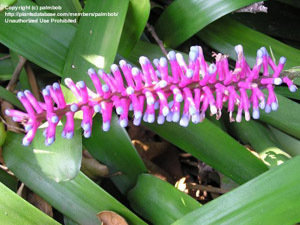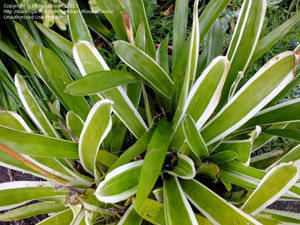Many times I chance upon a plant that provides beautiful surprises. Such is the case with matchstick bromeliad. I had always thought bromeliads were tropical beauties that required special care and protection. Most of my bromeliads are put in containers and moved to the greenhouse come winter.
One winter quite by accident, I left the matchstick bromeliad outdoors. I found it the following spring, all healthy and undamaged by the ravages of my Zone 8B winter. With this encouragement, I planted the bromeliad outdoors underneath a tree. Even now, ten or so years later, the matchstick bromeliad flourishes. Very little damage has been inflicted on the foliage, but the flowers are sometimes damaged by a freeze. This is unfortunate, for late fall and early winter is when the flowers bloom.
Matchstick bromeliad,
Aechmea gamosepala, (EEK-mee-uh or EK –mee-uh gam-oh-SEP-uh-luh) earns its common name because the flower spike bearing many thick purplish-pink bracts with iridescent bluish-purple tips looks somewhat like surreal matchsticks lined up the stem. After bloom, the flower spike remains a rosy pink color for a long time. In my garden, the plant blooms in late fall or early winter, and if protected, these flowers last for a couple of months. Flowers also last well in a vase.

Native to Argentina and Brazil, the matchstick bromeliad is a semi-epiphytic plant that can be mounted on bark or driftwood, in the fork of a tree or other support, or grown in light, well-draining soil. Bright green, smooth-edged leaves form a water-holding rosette. Plants spread by stolons (runners) from the mother plant and will quickly spread to fill a pot and put on a spectacular show when it blooms. Encourage bloom, if necessary, by placing the plant in a sealed bag with an apple for a couple of weeks. Ethylene gas given off by the apple stimulates bloom.
Place your matchstick bromeliads in shade to partial shade like that found underneath tall trees. Keep their cups filled with water, but if they are in soil, make sure it is well drained. When grown out of doors, falling leaves and other detritus provide necessary nutrients as they decay. Indoors, mist the plants occasionally with room temperature water and feed with a reduced strength water soluble fertilizer. Propagate by removing the offsets (pups) with a sharp knife.

A variegated form of matchstick plant is available called ‘Lucky Stripes’. Like the species, leaves are rich green, but margins are yellow to white. ‘Marti Gras’ exhibits a different leaf variegation, and a large form exists that grows more than 2 feet tall and wide. Leaves are thicker than the small form, but in other respects, it is very similar. A few other cultivars have been registered with varying characteristics, such as red tips or leaf edges, red leaves, differences in leaf variegation, flower color or intensity, and size.
A. cylindrica, according to some experts, is very similar but bears a thicker flowering stem with flowers placed closely together on the stem.
The matchstick plant is one species of the genus
Aechmea from the family
Bromeliaceae. According to GRIN (Government Resources Information Network), 36 species exist, including three varieties. The species is one of the most easily cultivated of the bromeliad genera. With its ease of growth, uncommon beauty, and absence of spines,
Aechmea gamosepala is an ideal bromeliad for a beginner. Of course, those of us who are not beginners enjoy the ease of this easy-to-grow, carefree plant.
Thanks to Palmbob for his image of the matchstick bromeliad and to RosinaBloom for the photograph of 'Lucky Stripe'.







